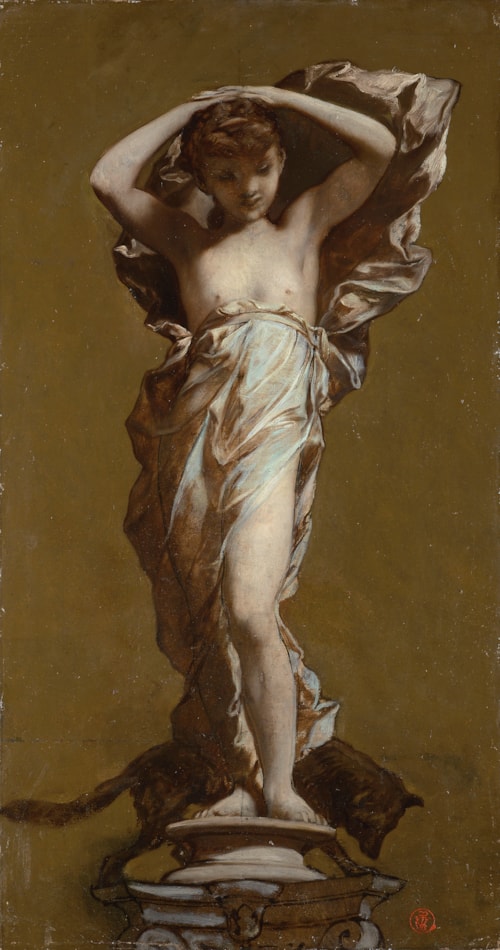
Pierre Victor GALLAND
Geneva 1882 - Geneva 1892
Biography
Born in Switzerland to French parents, the painter Pierre-Victor Galland spent his entire career in Paris, becoming one of the most celebrated décorateurs of the Second Empire. He studied metalwork with his father, a goldsmith, before training with the architect Henri Labrouste. Labrouste encouraged the young Galland to study with the painter Michel-Martin Drolling, and in 1843 he was hired as an assistant by the scenographer and décorateur Pierre-Luc-Charles Ciceri. It was in the field of theatrical painting and scenography than Galland established his artistic credentials. In 1848 he worked, alongside Labrouste, on the decoration of the Fête de la Concorde. Although Galland made his debut at the Salon in 1842, where he showed a portrait, he only very rarely exhibited his work during his career, and in fact did not return to the Salon until more than twenty years later, in 1863, when he showed some decorative panels. It was not until near the very end of his career, in 1890 and 1891, that he again chose to exhibit his work, at the Salon of the Société Nationale des Beaux-Arts.
Much of Galland's career was taken up with ceiling and wall decorations for private homes in Paris, so that he earned the sobriquet 'le Tiepolo des banquiers' ('the Tiepolo of the bankers') during the years of the Second Empire. Unfortunately, much of his work was destroyed during the Commune in 1871, including at the Ministry of Finance, the Hôtel Fould and the palace of Saint-Cloud. Galland also served as art director at the Gobelins tapestry factory, for whom he produced numerous designs for tapestries. These included a pair of portraits of Napoleon III and Princess Eugénie, for which the paintings survive while the tapestries were destroyed in a fire at the Gobelins in 1871. In 1873 he began teaching at the Ecole des Beaux-Arts, where he established a course in decorative art, open to the students of the faculties of architecture, painting and sculpture, which was to have a profound influence on later generations of artists. (Among his pupils was, briefly, Henri Evenepoel.) Galland was a talented draughtsman, and produced numerous studies of plants and flowers, used as a source of ornamental vocabulary for his decorative work.
During the Third Republic, Galland contributed to the decoration of the Panthéon in Paris, for which he painted a very large Preaching of Saint Denis in 1874, as well as producing paintings for the amphitheatre of the Sorbonne in 1886 and the Galerie des Métiers at the Hôtel de Ville between 1888 and 1892. He also painted the ceiling of the Salon de Musique of the Hôtel Jacquemart-André with a depiction of Apollo in his chariot. Galland's talent for decorative mural painting led to commissions to decorate homes in Lille, Nice, Marseille and elsewhere, as well as from several foreign clients, such as William H. Vanderbilt in New York and the banker Edward Baring, recently created Baron Revelstoke, for whom he painted the ceiling of the grand staircase at Dartmouth House in London. Galland also received commissions for decorative panels from other clients in London, Madrid, New York, Stuttgart and Saint Petersburg.
Two years after Galland's death in 1892, a substantial retrospective exhibition of his work, numbering around two thousand paintings and drawings, was organized by the Musée des Arts Décoratifs and held at the Palais de l'Industrie in Paris. The catalogue of the exhibition also served as the catalogue of the first of two auctions of the contents of the artist's studio, held in April 1894. Despite the success he enjoyed in his lifetime, and his highly influential role in French decorative arts of the 19th century, however, Galland remains a relatively obscure figure today. A large and comprehensive collection of his work, given by the artist's descendants in 1892, is today in the Musée d'Art et d'Industrie in Roubaix, which in 2006 hosted the first significant modern exhibition devoted to the artist, containing around 250 works.


